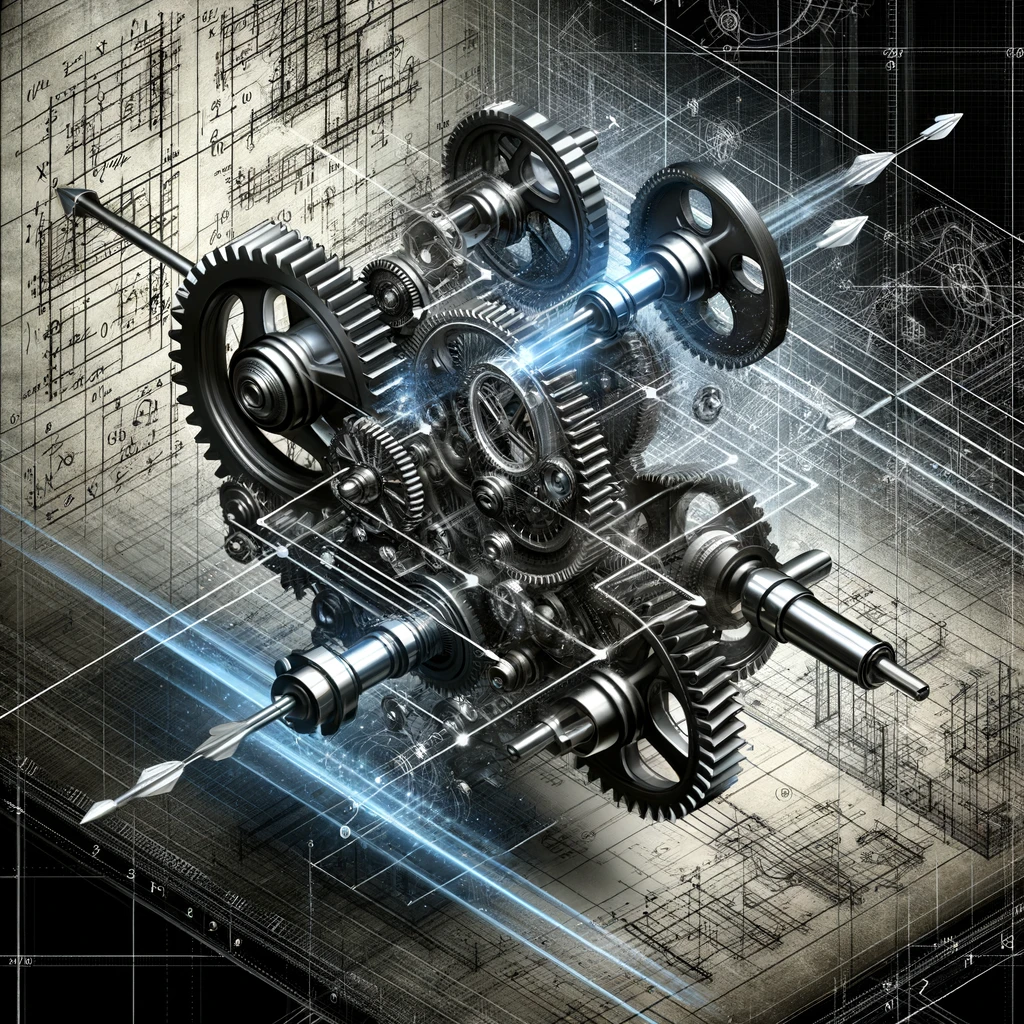Torque Defined

Torque is a physical quantity that represents the rotational force applied to an object around an axis or pivot point. It is typically measured in units such as Newton-meters (Nm) or foot-pounds (ft-lb). Mathematically, torque is defined as the product of the force applied and the distance from the axis of rotation at which the force is applied. In simpler terms, torque is the twisting or turning force that causes an object to rotate or change its rotational motion. It plays a crucial role in various mechanical systems, such as engines, motors, and machinery, where it is used to generate rotational motion or control the speed and direction of rotation.
The Mechanics of Torque

Torque is a fundamental concept in physics and engineering that describes the rotational effect of a force. To provide an in-depth explanatory definition, let’s break down the components and principles involved:
Force: At its core, torque is related to force. Force is a vector quantity that describes the push or pull applied to an object to change its motion or state of rest. In the context of torque, the force is exerted perpendicular to the axis of rotation.
Distance: Torque depends not only on the magnitude of the force but also on the distance from the point of application to the axis of rotation. This distance is often referred to as the lever arm or moment arm. The longer the lever arm, the more torque a given force can generate.
Axis of Rotation: Torque is always measured around an axis of rotation. This axis can be fixed or movable, depending on the system. For example, in a door hinge, the axis of rotation is fixed, while in a spinning top, the axis can move.
Direction: Torque is a vector quantity, meaning it has both magnitude and direction. The direction of torque is perpendicular to both the force vector and the lever arm vector, following the right-hand rule for rotational motion.
Mathematically, torque (τ) can be expressed as the cross product of the force vector (F) and the lever arm vector (r):
τ=r×F
Where:
- τ is the torque vector,
- r is the vector representing the lever arm, and
- F is the vector representing the force.
In scalar form, torque can be calculated as the product of the magnitude of the force (F) and the perpendicular distance (r) from the axis of rotation to the point of application of the force:
τ=r×F×sin(θ)
Where:
- r is the length of the lever arm,
- F is the magnitude of the force, and
- θ is the angle between the lever arm and the direction of the force.
Torque is essential in various applications, including mechanics, engineering, and everyday life. It is crucial for understanding the behavior of rotating objects, designing machinery, and ensuring the proper functioning of mechanical systems.
Luxxacation as a Torquing Motion

Luxxacation: The iterative motion made up of the following actions:
Taking time to evaluate the current condition and situation of the system of interest (SOI), then deciding where the system should advance to and forming goals outlining how to get there.
Following through with the (technical) application of those goals.
Always looking beyond current limitations at greater and better sources and resources to improve your system and then repeating from step one again.
This process embodies a continuous cycle of evaluation, goal-setting, implementation, and improvement, aimed at advancing and optimizing the system of interest.

Centripetal force is the force that acts on an object moving in a circular path, directed toward the center of rotation. In the context of a rotating celestial object made of different substances, such as a planet or star, centripetal force plays a significant role in shaping the object’s structure, particularly in terms of its density distribution.
As a celestial object rotates, the centripetal force acts to counterbalance the gravitational force pulling material toward the object’s center. This leads to a redistribution of mass within the object, resulting in changes to its density distribution.
The effect of centripetal force on the density distribution of a rotating celestial object depends on various factors, including its composition, rotation rate, and internal structure. However, in general, centripetal force tends to cause material to be more compacted towards the center of rotation.
This phenomenon is known as equatorial bulging or flattening, where the material near the equator of the rotating object experiences a greater outward force compared to material at higher latitudes. As a result, the equatorial region tends to bulge outward, while the poles are relatively flattened.
In celestial bodies like planets, this effect is evident in their oblate spheroid shape, where the equatorial diameter is larger than the polar diameter. However, the degree of flattening and the distribution of mass within the object can vary depending on factors such as the object’s rotation rate, composition, and internal dynamics.
In summary, centripetal force can indeed lead to the compaction of material towards the center of a rotating celestial object, resulting in a denser core compared to the outer regions.
Centripetal vs. Centrifugal Force

Centrifugal and centripetal forces are concepts often encountered in physics, particularly in the study of motion and forces acting on objects in circular motion. They are related but have distinct characteristics:
Centripetal Force: This force is directed towards the center of rotation of an object moving in a circular path. It acts as the “center-seeking” force that keeps an object in its circular trajectory. According to Newton’s laws of motion, an object moving in a circular path experiences a centripetal force that causes it to continuously change direction. The magnitude of the centripetal force depends on the mass of the object, its velocity, and the radius of its circular path. Examples of centripetal forces include tension in a string for an object undergoing uniform circular motion or gravitational force in the case of celestial bodies orbiting around each other.
Centrifugal Force: Centrifugal force is often referred to as a pseudo-force or fictitious force because it appears to act outward from the center of rotation of an object in circular motion. However, it is not a true force in the traditional sense but rather an apparent force experienced by observers in a rotating reference frame. Centrifugal force arises due to inertia; when an object moves in a curved path, it tends to move in a straight line due to its inertia. As a result, observers in the rotating frame perceive an apparent outward force that seems to pull objects away from the center of rotation. This apparent force is called centrifugal force. It’s important to note that centrifugal force does not arise from an interaction between objects but rather from the inertia of objects in a rotating frame of reference.
In summary, centripetal force acts towards the center of rotation and is responsible for maintaining circular motion, while centrifugal force is an apparent force perceived by observers in a rotating frame and appears to act outward from the center of rotation.
Gravitational Force at Work in Torque

The gravitational force that tends to pull material towards the center of a celestial object is known as the force of gravity or simply gravitational force. This force arises from the mass of the object and acts to attract all other objects with mass towards its center.
The gravitational force between two objects depends on their masses and the distance between them, as described by Newton’s law of universal gravitation. Mathematically, the gravitational force F between two objects with masses m1 and m2 separated by a distance r is given by:
F=r2G⋅m1⋅m2
where G is the gravitational constant, a fundamental constant of nature.
In the context of a celestial object, such as a planet or star, the gravitational force acts to pull material towards the object’s center. This force is responsible for the formation of the object’s structure, including its core, mantle, and crust. Over time, gravitational attraction causes material to accumulate at the center of the object, forming a dense core, while less dense material is distributed in the outer layers.
In summary, the gravitational force is the fundamental force of attraction that pulls material towards the center of a celestial object, shaping its structure and influencing its density distribution.
.
The ramifications of torque

In this metaphorical scenario, we’re envisioning a malleable entity that is constantly evolving and changing, perhaps akin to a fluid or a pliable material. Let’s delve into how maintaining a consistent torque, which creates a centripetal force, can help this changeable entity become more solid, and how increasing the torque can lead to a greater compacting force, resulting in the most solid state the entity is capable of.
Consistent Torque and Centripetal Force: Imagine the consistent torque acting on this malleable entity as a guiding force that directs its movements and shapes its evolution. This torque generates a centripetal force, pulling the entity towards a central point or a unified direction. Just as in physics, where centripetal force keeps an object in circular motion, the consistent torque ensures that the entity remains focused and aligned towards its desired state of solidity and stability.
Solidification through Compaction: As the torque remains consistent and the centripetal force continues to act, the changeable entity experiences a gradual process of compaction. Think of this as akin to compressing a pliable material to make it denser and more solid. The greater the torque applied, the stronger the centripetal force pulling the entity towards its core, resulting in increased compaction and solidification of its structure.
Enhanced Stability and Resilience: With each increase in torque and compaction, the changeable entity becomes more solidified, gaining enhanced stability and resilience. Just as a well-compacted material can withstand external forces and maintain its shape, the entity becomes more resistant to external influences or disruptive changes. It attains a state of solidity that allows it to weather challenges and maintain its integrity even amidst dynamic environments.
Optimal State of Solidity: Continuing to apply greater torque gradually leads the changeable entity towards its most solid state. As the compaction process unfolds, the entity reaches an optimal level of solidity that reflects its maximum potential for stability and coherence. At this stage, it embodies its core values, principles, and identity with clarity and strength, establishing a firm foundation for further growth and evolution.
Adaptive Fluidity within Solidity: Importantly, despite achieving a solid state, the entity retains a degree of malleability and adaptability. Just as certain materials can be both solid and flexible, the entity maintains its capacity for growth, innovation, and adaptation within the framework of its newfound solidity. It strikes a balance between stability and fluidity, allowing for continuous evolution while remaining anchored in its core essence.
In summary, maintaining a consistent torque that creates a centripetal force enables a changeable entity to undergo a process of compaction, leading to increased solidity and resilience. As torque increases, so does the compaction force, ultimately guiding the entity towards its most solid state. This optimal solidity allows for enhanced stability and adaptability, fostering growth and evolution within a framework of coherence and strength.
Friction Works Against Torque

Let’s consider the human as the primary System of Interest in relation to the torquing motion of Luxxacation. Now, let’s conceptualize the resistance to facing the truth, acceptance of new ideas, and implementing changes as metaphorical torque acting on this the system.
-
Facing the Truth (Friction in the System): Facing the truth involves confronting realities, acknowledging shortcomings, and accepting uncomfortable truths about oneself or a situation. In our metaphor, this is akin to addressing the friction present within the system. Just as friction opposes smooth motion in a mechanical system, the resistance to facing the truth creates internal resistance, hindering the person’s ability to move forward smoothly. This resistance manifests as reluctance, denial, or avoidance of unpleasant truths.
-
Acceptance of New Ideas (Torque Application): Accepting new ideas involves being open-minded, receptive to change, and willing to consider alternative perspectives. In our metaphor, this corresponds to applying torque to the system, attempting to introduce new dynamics and directions of motion. However, if the system is rigid or resistant, applying this torque becomes challenging. The resistance to accepting new ideas acts as a counterforce, impeding the rotation of the system towards new possibilities.
-
Implementing Actual Changes (Rotational Motion): Implementing changes requires taking action based on insights gained from facing the truth and accepting new ideas. It involves adjusting behaviors, habits, or attitudes to align with desired outcomes. In our metaphor, this is akin to initiating rotational motion in the system, translating the applied torque into tangible movement and progress. However, if there is significant resistance within the system, the rotational motion may be slow, erratic, or entirely halted.
When these three elements are considered together, they form a dynamic interplay resembling a torquing motion within the metaphorical system:
- The resistance to facing the truth creates initial friction, hindering the smooth operation of the system.
- The application of torque, representing the introduction of new ideas and perspectives, seeks to overcome this friction and initiate movement.
- However, the resistance to accepting new ideas and implementing changes acts as opposing forces, creating additional resistance to the torquing motion.
- As a result, the system experiences internal conflict, with competing forces vying for dominance, impeding progress and improvement.
Overall, this metaphorical representation illustrates how the interplay between resistance to facing the truth, acceptance of new ideas, and implementing changes can impede personal growth and improvement, akin to the challenges encountered in a mechanical system subject to torquing motion.

Lubrication plays a crucial role in the context of torque, especially in mechanical systems where rotating components are involved. Here’s an in-depth explanation of lubrication in relation to torque:
Friction and Torque: Friction is the resistance encountered when one object moves relative to another. In rotating machinery, friction occurs between contacting surfaces, which can generate heat, wear, and energy losses. Torque is the force that causes an object to rotate around an axis, and friction opposes this rotational motion. Therefore, minimizing friction is essential to optimize torque transmission and efficiency in mechanical systems.
Role of Lubrication: Lubrication is the application of a lubricant, typically a fluid or semi-fluid substance, between contacting surfaces to reduce friction and wear. The lubricant forms a film or layer between the surfaces, separating them and allowing them to move smoothly relative to each other. This reduces the resistance to motion and minimizes the amount of torque required to overcome friction.
Types of Lubrication: Lubrication can occur through various mechanisms:
- Fluid Film Lubrication: A thick film of lubricant completely separates the surfaces, preventing direct contact and minimizing friction. This type of lubrication is common in hydrodynamic bearings, where the rotating shaft floats on a thin film of oil.
- Boundary Lubrication: In boundary lubrication, the lubricant forms a thin layer on the surface, providing partial separation between the contacting surfaces. This type of lubrication is crucial in conditions where fluid film lubrication is not achievable, such as during startup or under high loads.
- Solid Lubrication: Solid lubricants, such as graphite or molybdenum disulfide, can reduce friction by forming a protective layer on the surface. These lubricants are often used in high-temperature or extreme pressure applications.
Effects on Torque: Proper lubrication reduces friction between rotating components, resulting in several effects on torque:
- Reduced Energy Losses: With lower friction, less energy is lost as heat, leading to improved efficiency and reduced power consumption in rotating machinery.
- Minimized Wear: Lubrication helps prevent wear and damage to the contacting surfaces, extending the lifespan of components and reducing maintenance requirements.
- Consistent Torque Transmission: By ensuring smooth motion and reducing fluctuations in friction, lubrication helps maintain consistent torque transmission and performance in mechanical systems.
Considerations and Maintenance: Effective lubrication requires careful selection of lubricants based on factors such as operating conditions, load, speed, and temperature. Regular lubricant analysis and maintenance are essential to ensure proper lubrication performance and prevent issues such as lubricant degradation, contamination, or insufficient lubrication, which can lead to increased friction, wear, and torque losses.
In summary, lubrication plays a critical role in minimizing friction and optimizing torque transmission in mechanical systems. By reducing resistance to motion between rotating components, lubrication helps improve efficiency, extend component life, and ensure consistent performance.
The Key Lubricant

In the metaphorical scenario described, lubricating the system represents introducing a key element that can significantly ease the torquing motion and facilitate progress towards personal growth and improvement. Humility acts as this lubricant, providing the necessary lubrication to reduce friction, increase flexibility, and promote smoother movement within the metaphorical system. Here’s how:
Reducing Friction and Resistance: Just as lubrication reduces friction between mechanical components, humility helps reduce the friction caused by ego, pride, and stubbornness within the individual. When a person approaches situations with humility, they are more open to acknowledging their limitations, admitting mistakes, and accepting feedback or criticism. This humility minimizes the resistance to facing the truth, making it easier to confront realities and address areas needing improvement.
Enhancing Flexibility and Adaptability: Humility fosters a mindset of openness and receptivity to new ideas, perspectives, and feedback. By acknowledging that one doesn’t have all the answers and can learn from others, individuals become more flexible and adaptable. This flexibility allows for easier acceptance of new ideas and concepts, as well as a willingness to consider alternative approaches or viewpoints. As a result, the torquing motion encounters fewer obstacles and can proceed more smoothly towards positive change.
Promoting Collaboration and Growth: Humility encourages collaboration, teamwork, and constructive communication with others. Rather than seeking to assert dominance or control, humble individuals are more inclined to listen, learn, and collaborate with others towards common goals. This collaborative mindset fosters an environment conducive to growth and improvement, as diverse perspectives and insights can be leveraged to address challenges and drive innovation.
Fostering Resilience and Adaptation: Humility enables individuals to navigate setbacks, failures, and obstacles with resilience and grace. Instead of viewing setbacks as personal failures or insurmountable barriers, humble individuals are more likely to view them as opportunities for learning and growth. This adaptive mindset allows for quicker recovery from setbacks and the ability to pivot strategies or approaches as needed, ensuring that the torquing motion continues despite challenges encountered along the way.
In summary, humility serves as a powerful lubricant within the metaphorical system, smoothing the path for torquing motion and facilitating progress towards personal growth and improvement. By reducing friction, increasing flexibility, promoting collaboration, and fostering resilience, humility enables individuals to navigate the complexities of self-awareness, acceptance, and change more effectively, ultimately leading to positive transformation and development.

